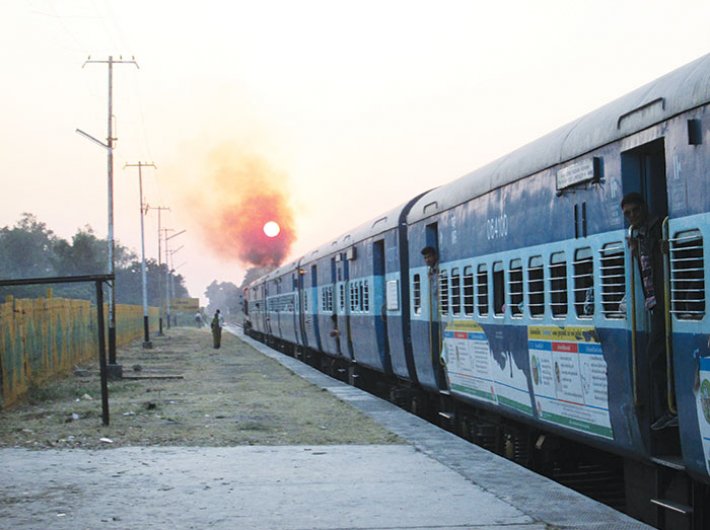Indian Railways sees promise in five percent biofuel blend. Big forex savings too
The growing consumption of diesel has been a matter of concern for the Indian Railways. Not only does its emission cause environmental damage, buying diesel involves huge foreign exchange outflows. To tackle these problems, the railways has decided to promote alternative fuels to run its fleet of over 4,000 locomotives.
On the World Environment Day (June 5) in 2015, the Research Designs and Standards Organisation (RDSO), under the ministry of railways, test-ran a locomotive on a fuel blend containing five percent biodiesel. Sources in the railway ministry say nearly Rs 100 crore was saved in 2015 with the five percent blending. The railways aim to raise the blending to 20 percent, which could raise the savings fourfold.
“Indian Railways consumes about 18 billion units of electricity and about 2.4 billion litres of fuel oil, which is more than two percent of the country’s energy consumption. Therefore, the Indian Railways has embarked upon ‘mission decarbonisation’ and ‘mission electrification’ with an aim to reduce dependence on imported fuel and rationalise the cost of energy for railways,” Ashwani Kumar Kapoor, member (traction), railway board, said at a press meet last year.
At present, there are 250 fuelling stations across all railway zones, of which nearly 50 stations provide biodiesel. “The Indian Railways is very much committed to going green. The department is highly focused on using biofuels, which is an environment-friendly way to run the trains. Hence, the railway ministry has established a department, Indian Railway Organisation for Alternate Fuels (IROAF), to look into the possible usage of alternative fuels in the railways. We are also focusing on solar power for environment-friendly usage of energy. We have also created a dedicated environment directorate to address the green issues,” says Anil Saxena, national spokesperson of the Indian Railways.
Biodiesel is made of oil from soyabean, rapeseed, sunflower, peanut, canola, palm and cottonseed. It may include animal fat. According to experts, the most common way to produce it is by a process called ‘transesterification’ of vegetable oil with an alcohol. In this process, vegetable oil is chemically reacted with an alcohol like methanol or ethanol in the presence of a catalyst like sodium hydroxide. After the chemical reaction, various components of the vegetable oil break down to form new compounds. “It is a low temperature and low pressure reaction. It yields high conversion [96-98 percent] with minimal side reactions. The byproduct, glycerine, also has economic value as it is used in manufacturing of hand cream, soap, toothpaste, etc.,” says RK Mishra, chief mechanical engineer, ministry of railways.
Cost-effective
The railways is the single largest bulk consumer of diesel in the country. Moreover, it consumes approximately 2.4 billion litres of diesel every year and imports tonnes of crude oil. The railways’ fuel bill is Rs 23,083 crore, including diesel, biodiesel, electric traction and salaries of staff at fuelling stations.
In terms of economic viability, biodiesel is nearly 8-10 percent cheaper compared to diesel. The total operative cost for biodiesel is around Rs 42 per litre, which includes conversion of raw material into biodiesel and also the transportation cost. In the railway budget for 2016-17, Rs 59.10 crore was earmarked for biodiesel.
Blending up to 20 percent
Till now, RDSO has cleared the use of five percent blend on diesel locomotives in all railway zones. Since the inaugural run of the biodiesel locomotive, most of the zonal railways have already implemented use of biodiesel, while others are in the process of doing so. “Even five percent use of biodiesel can lead to substantial savings in terms of foreign exchange, in addition to various other benefits. Use of higher blends [above five percent] is under study in consultation with engine manufacturers. It is expected that in the future, blending may go up to 20 percent,” says Mishra.
According to the National Policy on Biofuels drafted by the ministry of new and renewable energy, India’s energy security would remain vulnerable until alternative fuels to substitute/supplement petro-based fuels are developed based on indigenously produced renewable feedstocks. “An indicative target of 20 percent blending of biofuels, both for biodiesel and bioethanol, by 2017 is proposed,” the report reads.
However, 20 percent blending of biodiesel is not an easy target. The government has put a ban on using edible oils to produce biodiesel. Experts say that owing to the ban, the country is left with only non-edible oil resources to produce biodiesel. “In India, non-edible oil sources like Jatropha curcas, Madhuca indica and Pongamia pinnata are not grown in abundance, which makes it difficult to take blending up to 20 percent. In the US, biodiesel is used in abundance as usage of edible oil is also allowed,” says a railway expert.
No engine modification needed
Further saving costs, biodiesel can be freely used in diesel locomotives without any modification. Mishra adds, “Initially there was a suspicion that the use of biodiesel might require engine modification or a different type of engine, which would escalate the total cost. But during the inaugural run, it was found that it works perfectly fine with the same diesel engine.”
Environmental concerns
Against the backdrop of worsening ecological conditions, use of biodiesel is a welcome way to reduce air pollution. According to Dr Kafeel Ahmad, professor of civil engineering at Jamia Millia Islamia, diesel plays a sizeable role in polluting the air as it contains bigger particulate matter compared to other petroleum products. “The usage of diesel in transport is a big contributing factor to worsening air quality. Usage of biofuels would reduce usage of diesel in trains – though by a small fraction,” he says.
“The high energy demand in the industrialised world as well as the pollution problems caused due to the use of fossil fuels make it increasingly necessary to develop new renewable energy sources and hence the search for alternative fuels. Biodiesel is an attractive alternative to fossil fuels; it is biodegradable, non-toxic and has low emission profile as compared to petroleum fuels. Biodiesel is also carbon neutral. The CO2 released by burning biodiesel is of the same amount as that absorbed during the formation of the raw material. Biodiesel is a liquid fuel equivalent to petro-diesel with the difference that it is derived from biological sources. Although biodiesel can be used in its pure form, it is usually blended with standard diesel fuel. Blends are indicated by the abbreviation ‘Bxx’, where ‘xx’ is the percentage of biodiesel in the mixture, says Mishra.
In 2014, the railways had decided to promote use of alternative fuels like biodiesel in a big way. This was stated by the then minister of railways DV Sadananda Gowda at the inauguration of Bio-Fuels – 2014 conference with a theme: ‘Energize growth & Business opportunities in Biodiesel sector in India’ organised by Biodiesel Association of India (BDAI). Gowda had said that biofuels have a role to play in our efforts to address environmental concerns, particularly where we cannot otherwise easily decarbonise, like in the transport sector. “However, it is crucial that the biofuels used must be genuinely sustainable and cost effective. Unless these two imperatives are met, we would not be able to proliferate biodiesels in the manner we intend to,” he had added.
ankitasharma@governancenow.com
(The story appears in the January 16-31, 2017 issue)

